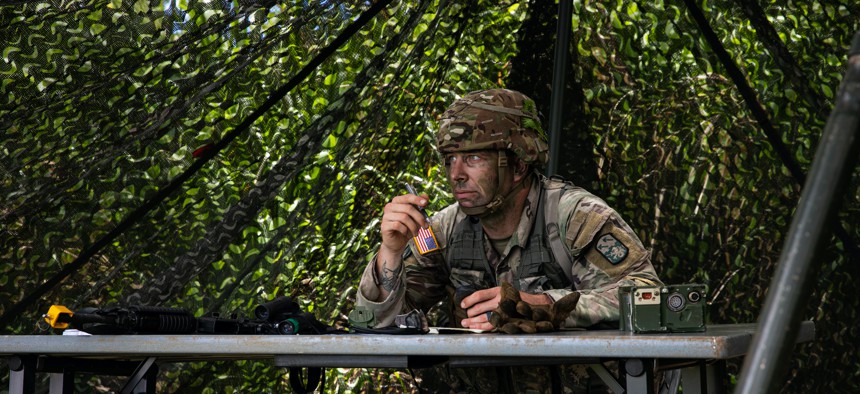
Staff Sgt. Jason Rader, a cyber network defender assigned to 94th Army Air and Missile Defense Command, scans the area while plotting points on a map during a series of warrior tasks and battle drill lanes at Lightning Academy, Wahiawa, Hawaii on June 2, 2021. U.S. Army / Spc. Rachel Christensen
General Makes Case for Army’s Role in the Indo-Pacific
“By putting boots on the ground,” Gen. Charles Flynn said, “we're demonstrating the will of the United States.”
The Army’s top officer in the Pacific is reminding people that the service’s capabilities and contributions as a land force is as important to the renewed competition in the Indo-Pacific as that of the Navy or Air Force.
“There is, when you look at a map, an awful lot of sea and air in that part of the region. But I don't want to miss the fact that more than half the globe's population lives in that region...And when I say that those people, they live on the land,” Gen. Charles Flynn, the commander of U.S. Army Pacific, said during a session at the Association of the United States Army’s 2021 annual meeting and exposition.
On land, competition over food, fresh water, and minerals is happening every day and the U.S. Army needs to be a counterweight to some of the destabilizing activities that China is involved in, he said.
Flynn also highlighted the important role local armies play in their country’s stability and in working with other countries. Working with these armies and building those relationships is a key contribution that the Army makes to the joint force in the region.
“So security, stability, and trust are all things that we're trying to make sure that we maintain our relationships and we maintain those relationships by being forward, by rehearsing in partnership with our allies and friends. And so the Army, and land power really does provide decisive campaign quality, joint integrated deterrence by being forward,” he said.
The interim national security strategic guidance from President Joe Biden’s administration highlighted the growing concern of competition with China. Flynn said China has been following “an incremental and insidious path because of the actions and behaviors that they continue to pursue, and some of the destabilizing activities that they're involved in, in the region.”
The Army will train its soldiers in Hawaii this month and Alaska in March, where the environment and conditions are similar to what they may encounter in the island chains, as well as on the Asian continent like India or South Korea, Flynn said. Soldiers also conduct training, exercises, and rehearsals with partners in the region. The Army’s Defender Pacific effort practiced joint integrated operations in several exercises from Guam to Thailand and the Philippines.
“This is a great illustration of exactly what we're trying to do out in the Pacific. And it does a couple of things here: it denies the [People’s Republic of China] key terrain, it increases our joint readiness by being forward and operating as a joint force. And it also increases the confidence of our allies and partners that we're going to be there, whether it's a typhoon or whether it's something worse,” he said.
Having forces forward in the region is important for the Army not just because of the work done with allies and partners, but also the ability to understand the environment and conditions that they must operate in. Right now, the service has “foundational capabilities” in the theatre that only they can provide to the joint force commander—engineering, logistics, signal, and integrated air and missile defense-- Flynn said, that is quickly scalable.
“Providing a persistent presence forward in the region is part of that posture equation. We do have to have those forces forward, we have to be there to understand the environment and the conditions that we're operating in. We have to be able to provide scalable command and control. We have to be able to provide planning, synchronization and coordination for Army capabilities, but for and on behalf of, the Joint Force,” he said.
The Pentagon has yet to release the force posture review that is expected to signal where troops and resources will be repositioned around the world. Nor has Defense Secretary Lloyd Austin released his new National Defense Strategy to replace the 2018 version.
Overall, having soldiers in the region allows the Army to be able to “see, sense, and understand” what is happening. And if something does happen where more people must deploy to the region, the Army is responsible for sustaining a joint force with infrastructure, distribution, and maneuver capabilities in the theatre.
“We've got to get those foundational capabilities that enable the joint force forward, we have to have persistent presence, we have to posture ourselves forward, bring capabilities that we know impose costs on our adversaries. Signal what we're doing out there. And then by putting boots on the ground, I think we're demonstrating the will of the United States to be forward in, as I said, the most consequential region, at the most consequential time against the most consequential adversary,” he said.




